CRG Research Report - © 1998-2021, Camaro Research Group
1967-1969 Camaro OEM Window Glass
Primary Author -
Reviewed by the CRG
Last Edit: 29-Jan-2021
Previous Edits: 15-Sep-2019, 30-Jun-2007, 27-Feb-2006, 30-Sep-2002,
17-Aug-2000, 19-Mar-2000, 24-Sep-1999, 13-Aug-1999
Original Release: 23-Dec-1998
|
Index
Overview
First-generation Camaro window glass was supplied by two manufacturers: Libbey Owens Ford
(LOF) and Pittsburgh Plate Glass (PPG). LOF was the overwhelming supplier for '67-'68 models,
and the dominant supplier in '69. PPG acted as an alternative supplier of Camaro glass and
was the primary supplier in '67-'69 to the sister model of the Camaro, the Pontiac Firebird.
Either supplier for could provide glass to either GM division in the event of a shortage,
but the only PPG glass use that CRG has verified to date in 1967-68 Camaro is the
occasional use in 1967 vent window glass. There was an increase in the amount
of PPG glass in '69 Camaros, especially at the Norwood Camaro assembly plant,
possibly due to the production of the Firebird moving to Norwood in April of 1969.
(LOF was purchased by Pilkington, which was then purchased by Japanese supplier NSG (Nippon
Sheet Glass), which then abandoned the LOF trade name in order to consolidate global
operations. While LOF glass for classic restorations had been reissued for a time under
Pilkington management, that classic glass division was shut down after the NSG acquisition
and those products with vintage markings are no longer available from NSG/Pilkington.)
During the late 1960's, LOF had a number of automotive glass manufacturing facilities.
The primary LOF manufacturing sites for Camaro glass were LOF Plants 6, 8, and 10. Plant 6,
in Rossford, OH (next to Toledo), supplied tempered glass to both assembly plants (to-date,
CRG has found only vent window glass from this factory in Camaros). LOF Plant 8 primarily
supplied Norwood. Plant 10 in Lathrope, CA primarily supplied glass to the Van Nuys assembly
plant.
Despite the typical use of LOF Plant 8 glass at the Norwood Camaro factory, and LOF Plant 10
glass by the Van Nuys Camaro assembly plant, the evidence from original vehicle research
shows that each assembly plant infrequently used glass from the other LOF plant. This
was done sufficiently often that glass plant location cannot be used
as a primary discriminator for determining glass originality. (However
it can be useful "circumstantial" evidence, as a secondary
discriminator when combined with production dates, etc.)
While certain aspects of the marking systems of these two suppliers
were known, there were many glass details that were not known. We were fortunate
to be able to access the expertise of supplier experts for this information.
However, certain details had been "lost" due to the passage of time
and could only be determined by reviewing and documenting a large population of original
window glass.
Automobile Glass Manufacturing Processes
There were three different manufacturing processes used for auto glass
during the first-generation Camaro era:
- Plate Glass
- In the late '60's, it was still in common use, but as a
discontinuous process (the glass is made in discrete pieces)
manufactured by an older technology, it was gradually being phased out
in favor of float glass.
- Float Glass
- The successor to plate glass, float glass is created in a
continuous process of floating molten glass on molten metal, typically tin,
that results in higher uniform glass thickness and flatness at a lower cost.
Float glass is the predominate type in use currently.
- Laminated Glass
- The third glass type, used for windshields, is
laminated glass, which is fabricated by sandwiching and
bonding annealed glass (annealed glass has been processed to
reduce residual stress - unlike tempered glass)
on both sides of a tough transparent plastic
core. (Plastic by itself is too soft to be sufficiently
resistant to long-term abrasive wear of windshield wipers,
or even car washing.) In the late '60s, laminated glass had already long
been in use for windshields for safety purposes, as, upon severe impact,
the plastic core of laminated glass retains most of the glass fragments
and prevents many previously common occupant injuries caused
by foreign object impact to the windshield.
- Tempered Glass
- Tempered glass results not from a glass creation process, as does
plate and float glass, but from a post-processing thermal treatment.
In automotive use, both plate glass and float glass are tempered to
improve damage tolerance. Glass, by itself, is not damage resistant;
it is easily scratched by a hard object, and since glass has a very
low fracture toughness, small surface scratches result in failure /
breakage at very low tensile stress levels.
However, plate or float glass can be made more damage tolerant by
inducing a compressive stress on the surfaces of the glass by means of
a thermal treatment. If the surfaces of the glass are placed in a
pre-loaded compressive stress state via the tempering process, the
inevitable minor surface scratches (cracks) do not experience a
tensile stress, and thus cannot easily grow under typical loads. This
results in a much more durable, and safe, glass product.
Both tempered float glass and laminated glass remain in common automotive use
today. Plate glass is no longer produced for automotive use in the US.
Government Regulatory Safety Standards
By the mid-1960's, specific safety standards for glass had been
enacted into law by individual states as well as by the U.S. Federal
government, affecting glass development and usage. However development
and passage of the landmark Motor Vehicle Safety Act of 1966 was a
prime motivator for many changes during this period. This U.S.
legislation also created NHTSA, the National Highway Traffic Safety Administration,
a division of the U.S. Department of Transportation (DOT).
NHTSA develops federal standards on automobile safety, three of
which are recorded in Volume 49 of the Federal Motor Vehicle Safety
Standards (FMVSS); Code of Federal Regulations, 571.205. They are
standard numbers 205, Glazing Materials (glass); 209, Seat Belt
Assemblies; and 108 on Lamps, Reflective Devices and Associated Equipment.
FMVSS Part 205 on glass, which originally took effect on 1 Jan 1968,
initially referenced SAE J673 (Jun 1960), an earlier performance
specification for motor vehicle glass developed by the Society of Automotive Engineers (SAE).
The reference was later changed to ANSI Z26, an update of J673 that is
maintained by SAE but published by the American National Standards Institute
(ANSI). This performance specification is the one that all
manufacturers of vehicles being sold in the U.S. are required to meet.
The vehicle manufacturers, in turn, flow this requirement down to the
glass manufacturers.
Glass terms previously in use but obsoleted with the advent of Federal
glass standards, include:
- single-strength
- 0.090-inch (3/32-inch) thick glass.
- double-strength
- 0.125-inch (1/8-inch) thick glass.
Glass Marks
Federal Marks
The new Federal regulations at the time of the first-generation
Camaro required only four types of marks on motor vehicle glass:
- the AS (American Standard) number (classified by ANSI Z26
and Part 205),
- the M (Model) number (assigned by the manufacturer),
- for shaded glass, the start of the AS-1 portion that meets the
clarity requirement must be so marked on the windshield (located
on the passenger side, and shown in the illustration below from the exterior), and
- (eventually, for later glass) the DOT manufacturer number (assigned by NHTSA)
| AS-1 Mark on Shaded Windshield |
|
1967 Van Nuys Backlight
Plate Glass, M55 AA |
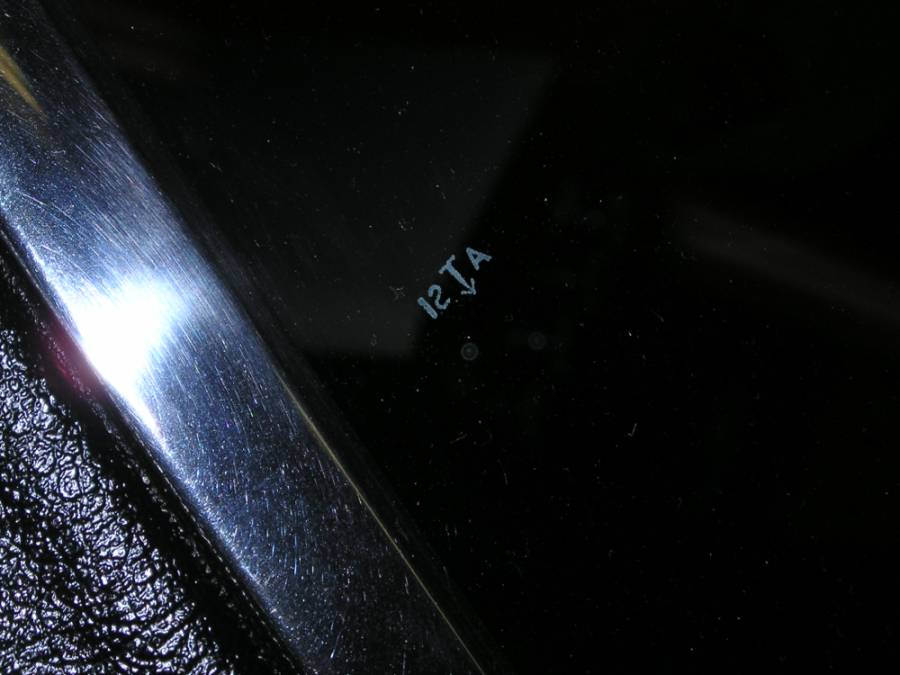
| |
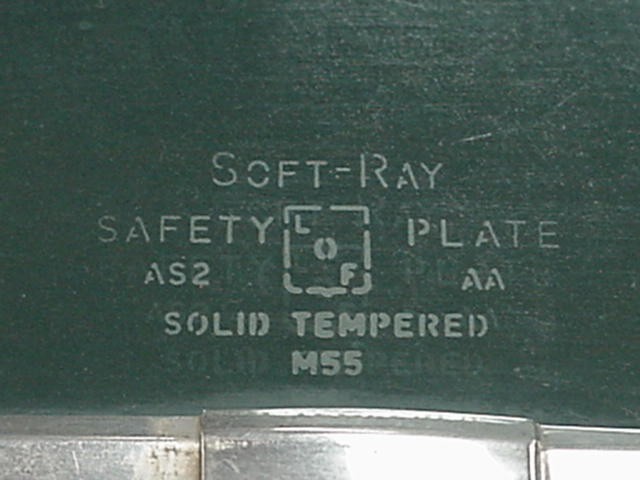
|
State Marks
Historic state regulations, many not yet revoked, required other
additional marks, such as "Safety," "Solid Tempered," and "Laminated,"
as appropriate.
GM Marks
Additionally, General Motors itself required several specific marks on
OEM glass, including:
- Shaded
- Added to tinted GM OEM windshields when they
included the upper, dark (non-AS1), tint band. For
regulatory purposes these windshields are only AS1 glass
below the tint band.
- Plate
- Added to plate glass for GM OEM applications.
- Flo-Lite
- Added to float glass for GM OEM applications; Flo-lite is
a GM tradename and is not used for other OEM glass.
- Soft-Ray
- Added to tinted GM OEM glass. Soft-Ray is a GM tradename and
is not used for other OEM tinted glass. Tinted OEM glass of
this era was green in color, whereas current Soft-Ray glass is blue.
For LOF and PPG to produce glass with GM specific marks with minimum
risk and maximum manufacturing freedom, agreements between the
suppliers and GM allowed for excess OEM glass that was not purchased
by GM to be sold by LOF or PPG on the aftermarket, while retaining
the GM tradenames of Soft-Ray and Flo-Lite.
Supplier and non-GM OEM Tradenames
Glass supplier tradenames, like "Duplate," "Solex," "E-Z-Eye," and
"SunShade" do not appear on GM OEM Camaro glass. Glass tradenames from other
OEMs also obviously did not appear on GM glass. For example,
"Safeguard," which is a tradename for Chrysler glass.
The "AS" Glass Classifications
The AS (or American Standard) glass codes are listed in the ANSI Z26
standard classification of motor vehicle glass produced by the Society
of Automotive Engineers (SAE). Note that ANSI Z26 is a "performance"
standard that sets minimum requirements for the functional performance
of a product. In other words, it doesn't tell manufacturers how to make the glass
but rather what functions the glass must perform. While a number of
motor vehicle glasses are listed in this standard, for
first-generation Camaros there are only two classifications that apply:
- AS-1 Laminated glass, windshield only
- Must pass the various ANSI Z26 tests/requirements for windshields,
which include impact standards and a minimum of 70% light transmissibility.
AS-1 glass is typically composed of two pieces of 1/8-inch glass
laminated on either side of 0.030-inch of PVB plastic.
- AS-2 Laminated or tempered glass, side/rear only
- This glass is required to pass ANSI Z26 tests for side glass,
including side impact requirement and a minimum of 70% light
transmissibility. This glass is typically composed of one sheet of
thick tempered glass (Solid Tempered) or (not seen on Camaros) two
layers of thinner glass laminated to either side of a 0.015-inch PVB
plastic core.
LOF Glass Markings
Marks from 1966 through December 1968
Transcriptions of two different examples of the variations of LOF
OEM glass markings are seen below in their pre-1969 version
(e.g., without the DOT mark). Note that "date/plant" is not
literal but indicates the location of the Date and Glass Plant code
discussed later. See also the later discussion of marking details,
such as hyphen use.
SOFT-RAY
SAFETY L PLATE SAFETY L FLO-LITE
AS2 O date/plant AS-2 O date/plant
F F
SOLID TEMPERED SOLID TEMPERED
M51 M74
DOT code added in calendar year 1969
While not part of the original regulations under Part 205, subsequent
revisions required addition of a manufacturers "DOT-xx" code to the
glass label. DOT numbers for auto glazing were required to be
effective April 1, 1973.
The LOF number is 15, and the PPG number is 18. While not required by law,
LOF began marking their glass with the DOT
number as soon as it was assigned and the glass stencils were updated.
This DOT mark is first noticed beginning with January 1969 LOF glass
production. We believe that glass on Camaros built prior to January 1969 should
not show the DOT mark. An example transcription of DOT marked glass is shown below.
SHADED
SOFT-RAY
SAFETY L FLO-LITE
AS1 O date
F
SOLID TEMPERED
DOT 15 M4
LOF Glass Model Numbers
As described previously, vehicle glass was manufactured by three
different processes; Plate, Float (Flo-Lite), and Laminated; in both
clear and tinted types, and in two different thickness (for Plate and
Float). There were 10 different types of glass in common use. LOF
assigned model numbers to each type of auto glass, and each type
received a different model number mark as required by ANSI Z26. These
model numbers are discussed below and summarized in the application
table.
Three types of AS-1 glass were used for the windshield; M3 for untinted, M4 for tinted,
and M24 for 68-69 tinted glass made at plant 10 in CA. (It is not known why plant 10
used this M24 model number or if was different than the M4 glass). Eight types of AS-2 glass
were used in the rest of the car. The stronger, 1/4-inch thick, AS-2 tempered glass was
normally used in Camaro doors, since the door glass is large and
frameless with little support from the car when in the raised position
- and is especially vulnerable when the door is being slammed closed.
Thinner, 3/16-inch thick, AS-2 tempered glass was normally used in the
vent (1967), rear quarter, and backlight (rear window) positions.
These normative practices were
sometimes violated. In rare cases the thicker AS-2 glass was
substituted in areas where the thinner glass was normally used -
perhaps to keep production moving at the glass factory. There are even
a few rare cases observed, and then (to-date) only in 1967 model LOS
cars, where the thinner 3/16-inch thick glass was used in the doors.
1967-1969 Camaro LOF Glass Models
Model Rating Tint Thk Type Typical Application
------ ------ ---- ---- --------------- -----------------------
M3 AS1 No 1/4 Laminated Plate windshield
M4 AS1 Yes 1/4 Laminated Plate windshield
M24 AS1 Yes 1/4 Laminated Plate windshield (plant 10)
M51 AS2 No 1/4 Tempered Plate door
M52 AS2 No 3/16 Tempered Plate vent, quarter, backlight
M54 AS2 Yes 1/4 Tempered Plate door
M55 AS2 Yes 3/16 Tempered Plate vent, quarter, backlight
M71 AS2 No 1/4 Tempered Float door
M72 AS2 No 3/16 Tempered Float vent, quarter and backlight
M74 AS2 Yes 1/4 Tempered Float door
M75 AS2 Yes 3/16 Tempered Float vent, quarter and backlight
|
Marking Method
LOF sand-blasted almost all glass marks with a stencil. The
only exception was the early '68 model "Astro-Ventilation" mark, which used
fired-on white ceramic paint [a thank you for this correction goes to Dan
DelGratta of LOF]. Decals are incorrect. Also incorrect is reproduction
glass that uses baked on black enamel for marking (often seen on modern
glass, and still prevalent for the AS1 mark even on repo glass
that has had "correct" marks added). Note that there are some stencil
differences from one plant to another. LOF Plant 16, in particular, used a
distinctly different stencil from the other LOF plants that supplied
Camaro glass. Consistent marking patterns include:
1967-1969 Camaro LOF Glass Marking Patterns
Windshield - marked on outside for viewing from inside
Side glass - marked on EITHER side for viewing from inside
Backlight - marked on outside for viewing from outside
Astro-Ventilation - marked on inside for viewing from outside
logo (early 68)
|
LOF Date and Plant Codes
The LOF date code is a two-letter code - a one-letter month code followed by
a one-letter year code. For example, a code of NX is interpreted as January 1968.
LOF Plant Codes
Plant 2 Shreveport LA
Plant 3 Parkersburg, WV
Plant 4 East Toledo, OH
Plant 6 Rossford, OH
Plant 8 East Toledo, OH
Plant 10 Lathrop CA
Plant 11 Rossford OH
|
| |
1966-1970 LOF Glass Dating System
LOF Month Code - First Character
N X L G J I U T A Y C V
Jan Feb Mar Apr May Jun Jul Aug Sep Oct Nov Dec
LOF Year Code - Second Character
A Z X V T N Y U L I C G J
1953 1954 1955 1956 1957 1958 1959 1960 1961 1962 1963 1964 1965
1966 1967 1968 1969 1970 1971 1972 1973 1974 1975 1976 1977 1978
1979 1980 1981 1982 1983 1984 1985 1986 1987 1988 1989 1990 1991
|
|
The "-xx" suffix on the LOF date code is the plant code. "-10"
indicates the source was the Plant 10 Lathrope, CA facility that
supplied primarily the Van Nuys, CA Camaro assembly line. A "blank"
code (no plant code) was used by Plant 8 that supplied all windshields
to both Camaro factories, as well as tempered glass primarily to the
Norwood, OH assembly line. A "-16" code actually denotes Plant 6
rather than Plant 16 (which didn't exist); this plant supplied mostly
vent windows. For unknown reasons, there was an extra 1 prefix in the mask.
Our findings to date show the following marking variations:
- M3, M4, and M5x models did not use a hyphen in the ASx codes
while M7x models did use a hyphen in the AS-x codes
- M5x models used a narrower font for "SOLID TEMPERED"
than did the M7x models
The Astro-Ventilation logo was dropped from the 1968 door glass about
Nov or Dec '67 production. However, one pane of
apparently original May '68 door glass with the Astro-Ventilation logo
has been observed in a 05C build. The mating glass on the opposite
side of the vehicle is Sep '67 Astro-Ventilation glass. We believe that the May '68
pane had the Astro-Ventilation logo added by LOF to create a matching
set, presumably to use up left-overpanes. At least two other late '68 cars have
been observed with late 1967 Astro-Vent glass.
The DOT mark was added to most LOF glass during stencil changes made
for January 1969 production. However, this addition was not yet a
Federal requirement, and a few panes of non-DOT LOF glass have been
observed in 1969, but these appear to be the exception rather than the
rule.
PPG Glass Markings
The PPG Glass was marked with a combination plant and date code. The format
is PP-MMY, where PP is the plant code and MMY is the Month and
Year. So 27-29 was made in the Tipton, PA plant in February 1969, 27-109 was
made in October 1969. The plant codes and glass model information are:
PPG Plant Codes
Plant Location Focus
1 Creighton, PA OEM windshields
25 Greensburg, PA (non F-body)
26 Crestline, OH OEM rear/side glass
27 Tipton, PA OEM rear/side glass
28 Evansville, IN (non F-body)
41 Berea, KY (non F-body)
81 Oshawa, Ontario (non F-body)
|
| |
OEM PPG Glass Types
M20.x = untinted side/rear glass
M25 = laminated windshield glass
M27.x = tinted side/rear glass
The .x suffix indicates nominal thickness in 1/32"
.6 = 3/16-inch thickness
.8 = 1/4-inch thickness
The decimal point may be a space, or may be absent,
such as: M20.8, M20 8, or M208
|
|
Examples of PPG glass marks:
SAFETY Flo-Lite
Ex #1 AS-2 PPG 26 108
SOLID TEMPERED
M208
The SAFETY mark, AS code, GM Flo-Lite tradename, and SOLID TEMPERED mark are as described above.
"26" is the PPG plant code for Crestline, OH and "108" is the PPG date code, 108=Oct 1968.
The M-code is the PPG glass type for untinted side/rear glass at 8/32-inch thick
(1/4 inch). Note no decimal point or space prior to the thickness code in this example.
SOFT RAY
SAFETY PPG FLO-LITE
Ex #2 AS-2 27-97
SOLID TEMPERED
M27 6
In this second example of OEM glass, the GM tradename for their tinted glass, SOFT RAY
is the same as used on LOF glass. The plant/date code indicates Tipton,
PA glass made in September of 1967. The glass is type M27 (tinted M20) at
6/32-inch thick (3/16 inch).
SUNSHADE
PPG SOLEX
Ex #3 DUPLATE
Replacement LAMINATED
SAFETY PLATE
AS1 M30 25 102
DOT 18
Third example is of NON-OEM PPG windshield replacement glass. Sunshade and
Solex are PPG tradenames. Duplate was a PPG name for early laminated glass.
The type for this non-OEM glass is M30, the date is Oct 1972, and the DOT code
now appears.
Acknowledgments
The author particularly wants to acknowledge the help and assistance
of Mr. Sig Herliczek of Pilkington LOF and Mr. Frank Lovett of PPG, as
well as the helpful critique of the other members of the Camaro
Research Group. Many thanks are also owed the large number of Camaro
owners who patiently contributed original window glass data to this
project, oftentimes enduring repeated contacts for additional
information.
Appendix A
Glass Mark Photos
Ordered from the front of the vehicle to the rear.
1967
1967 Van Nuys Tinted Windshield
Laminated Glass, M4 VZ |
1969
1969 Norwood Tinted Windshield
Laminated Glass, M4 YX |
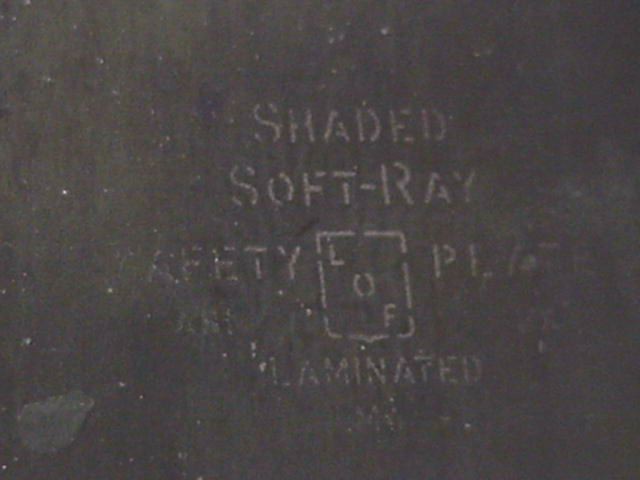
|
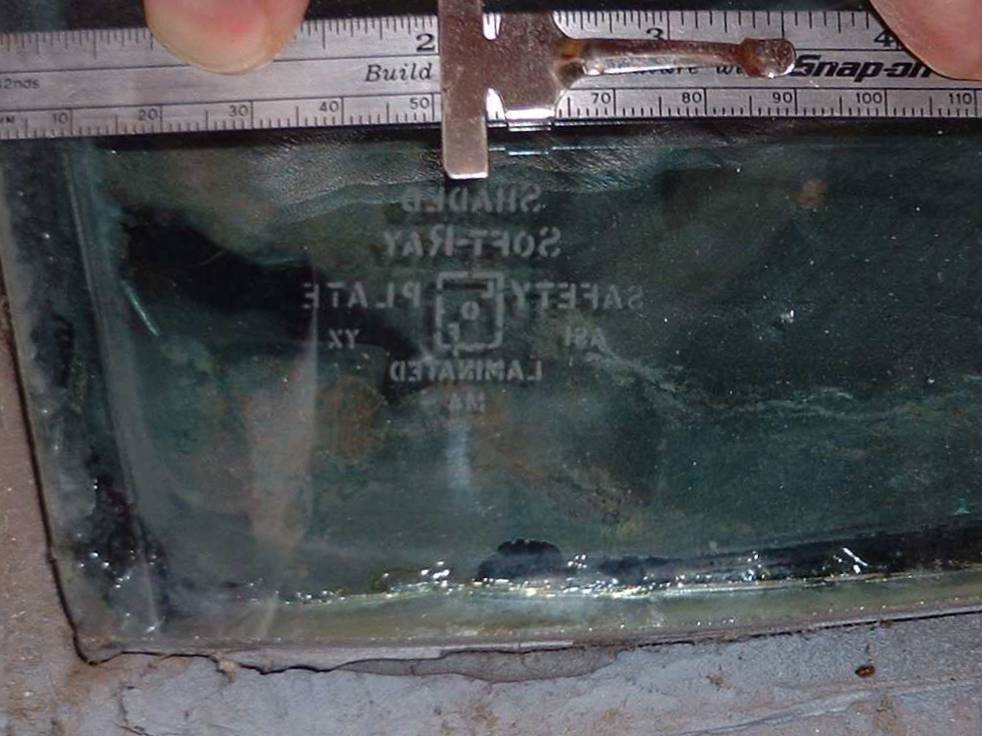
|
| |
1967 Norwood Psg Vent
Plant 16 Plate Glass, M52 XZ |
1967 Van Nuys Psg Vent
Plant 16 Plate Glass, M52 IA |
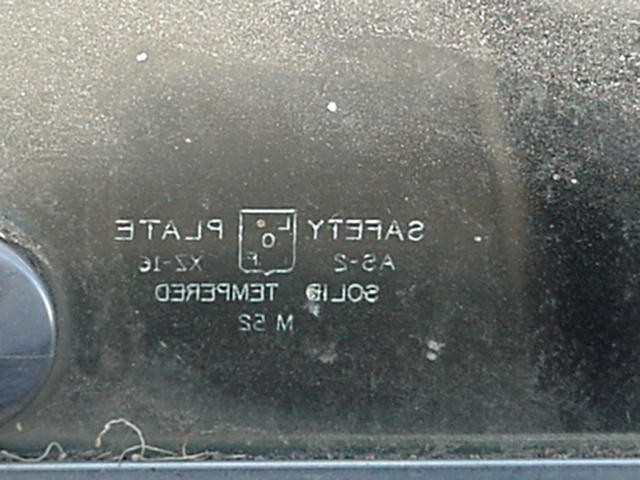
|
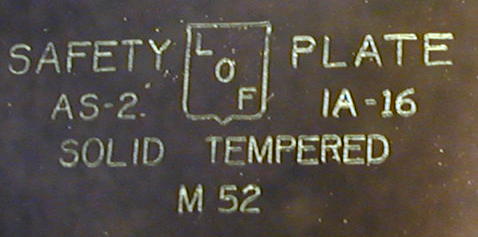
|
| |
1967 Van Nuys Driver Door
Plant 10 Float Glass, M74 YA |
1969 (Plant unknown) Driver Door
Plate Glass, M51 XV |
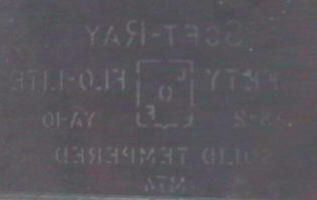
|
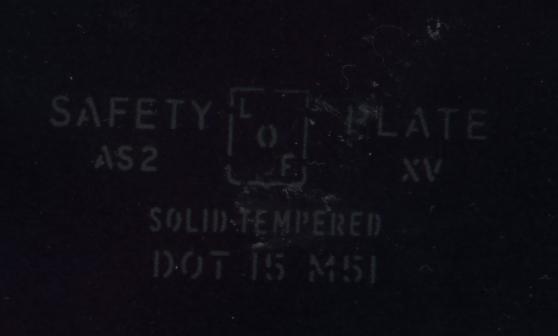
|
|
1969 Norwood Passenger Door
Plate Glass, M51 JV |
|
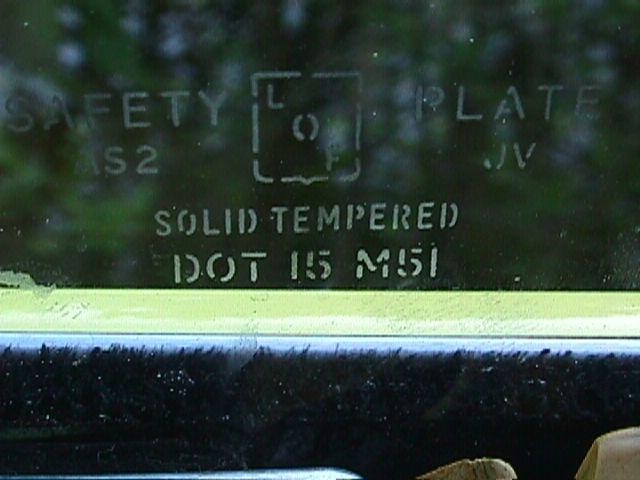
|
| |
1967 Norwood Driver Quarter
Plate Glass, M55 CA |
1969 Norwood Driver Quarter
Plate Glass, M52 JV |
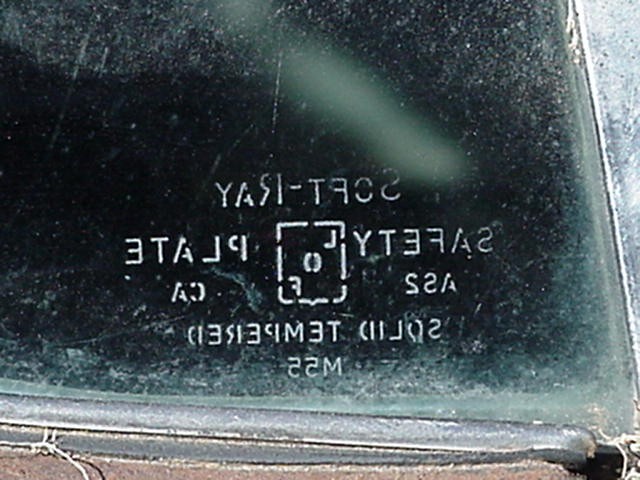
|
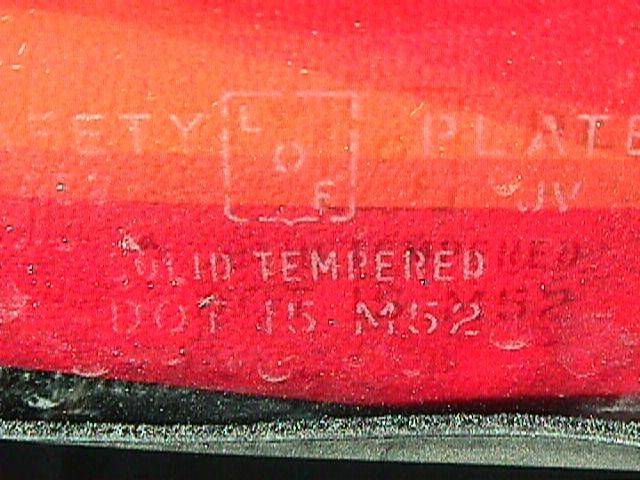
|
| |
1967 Van Nuys Passenger Quarter
Plant 10 Float Glass, M74 YA |
1969 Norwood Passenger Quarter
Plate Glass, M52 JV |
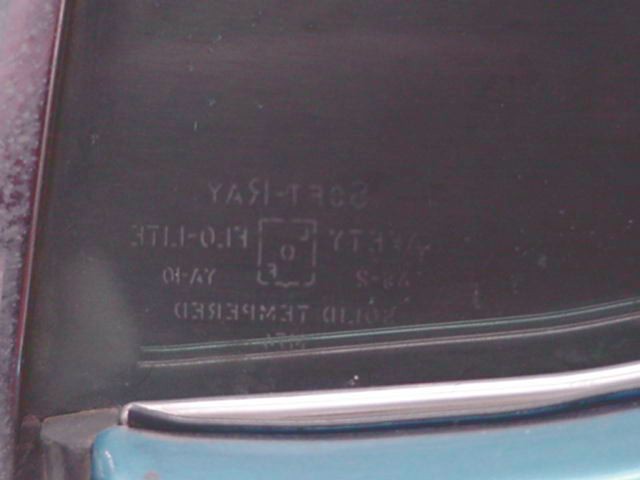
|
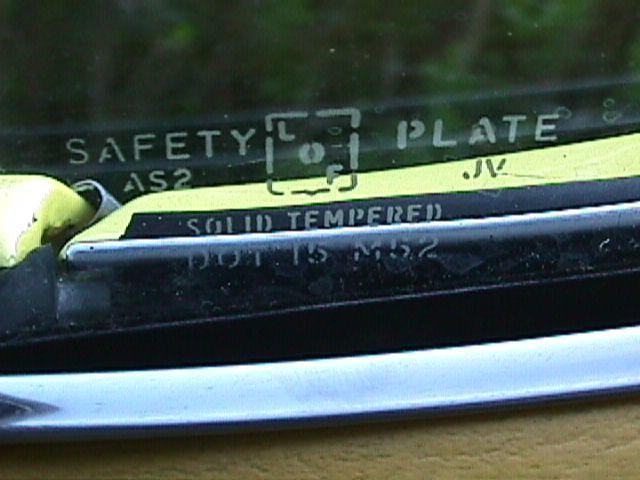
|
| |
1967 Van Nuys Backlight
Plate Glass, M55 AA |
1969 Norwood Backlight
Plate Glass, M52 JV |

|
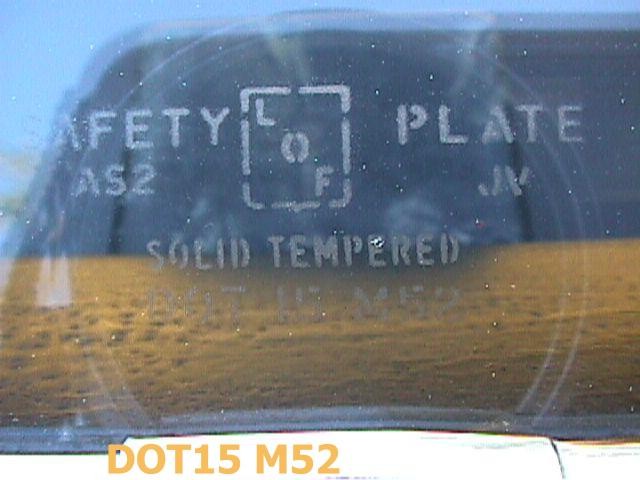
|

